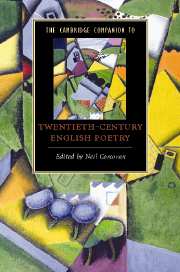2 - Modernist poetic form
from Part I - Contexts
Published online by Cambridge University Press: 28 January 2008
Summary
If Modernism implies experimentation with the limits of art, shocks and thrills beyond all previous bounds, then, in the matter of poetic form, the Victorians were more Modernist than the Modernists themselves. As inventors of new stanza forms, transgressors of prosodic boundaries and explorers of new sonorities of verse, the Victorians were unsurpassable - the Modernist poets began their careers in a world in which the Victorians had already broken all the rules and developed strange and idiosyncratic new rules. It might be good to start this review of Modernist poetic form with a catalogue of some of the formal innovations of the nineteenth century, and their relation to the aesthetics of Modernism.
Scrutiny of rhyme
Rhyme has always been a somewhat dubious attribute of English poetry, partly because classical Greek and Latin poetry did not use it. Around 1603 Samuel Daniel felt he had to publish A Defence of Ryme, because Campion and others had attacked it; and Milton began Paradise Lost (1674) with a note defending the rhymelessness of his epic: he called rhyme 'to all judicious ears, triveal, and of no true musical delight'. By the nineteenth century the propriety of rhyming was no longer an issue - the canon of rhymed poetry was obviously too magnificent to be dispensed with - but poets kept experimenting with aspects of rhyme.
- Type
- Chapter
- Information
- Publisher: Cambridge University PressPrint publication year: 2007
- 3
- Cited by

